“Global IR Spectroscopy Market to reach a market value of USD 1.8 Billion by 2031 growing at a CAGR of 6.3%”
The Global IR Spectroscopy Market size is expected to reach $1.8 billion by 2031, rising at a market growth of 6.3% CAGR during the forecast period.
Biological research represents a significant and growing segment within the IR spectroscopy market, driven by the demand for advanced analytical techniques to unravel the complexities of biological systems, understand disease mechanisms, and develop innovative therapies and diagnostics. Consequently, the Biological research segment would generate approximately 10.11% share of the market by 2031. IR spectroscopy continues to play a pivotal role in advancing biological research, offering unique capabilities for studying biomolecular structure, function, dynamics, and interactions in health and disease.
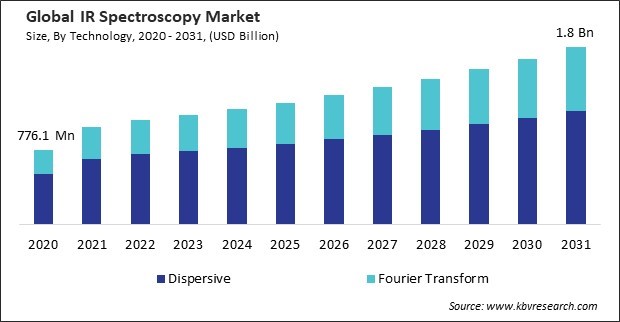
The major strategies followed by the market participants are Product Launches as the key developmental strategy to keep pace with the changing demands of end users. For instance In December, 2023, Shimadzu Scientific Instruments, a subsidiary of Shimadzu Corporation, has unveiled its latest offering: the IRSpirit-X series Fourier transform infrared (FTIR) spectrophotometers. This series includes three models: the entry-level IRSpirit-LX, the high-sensitivity IRSpirit-TX, and the moisture-resistant IRSpirit-ZX. In November, 2023, Thermo Fisher Scientific, Inc. introduced the Thermo Scientific™ ARL iSpark™ Plus Optical Emission Spectrometer series to enhance elemental analysis efficiency in metal industries and labs. Tailored for metal production, processing, recycling, contract, and research labs, the ARL iSpark.
Based on the Analysis presented in the KBV Cardinal matrix; Thermo Fisher Scientific, Inc., Hitachi High-Tech Corporation and ABB Group are the forerunners in the Market. In March, 2024, Thermo Fisher Scientific, Inc. has introduced the Thermo Scientific™ Nicolet™ Apex FTIR Spectrometer, an advanced infrared spectrometer designed for diverse applications such as materials analysis, pharmaceutical research, and environmental monitoring. And Companies such as Carl Zeiss AG., Agilent Technologies, Inc., and Revvity, Inc. are some of the key innovators in Market.
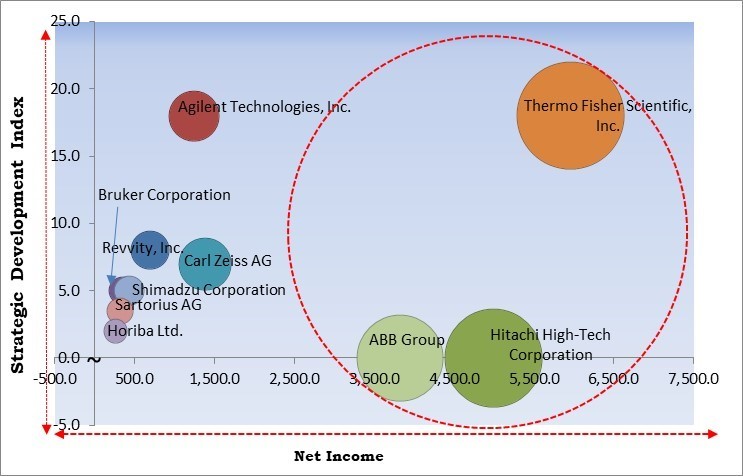
Advancements in instrumentation and technology play a crucial role in boosting the IR spectroscopy market by enhancing the capabilities, performance, and usability of IR spectroscopy instruments. Thus, as technology continues to evolve, the future of IR spectroscopy holds promise for further advancements in sensitivity, resolution, speed, portability, and integration, unlocking new opportunities for research, analysis, and problem-solving in diverse industries and scientific disciplines.
As healthcare systems worldwide evolve to meet the growing demand for medical services and advanced diagnostics, there has been a parallel increase in the establishment of healthcare institutions and clinical research centers across regions. Therefore, as the number of healthcare institutions and clinical research centers continues to grow worldwide, the demand for IR spectroscopy instruments, accessories, and services is expected to rise correspondingly.
The complexity of data interpretation poses a significant challenge in the IR spectroscopy market, hindering its widespread adoption and utilization across industries and research fields. Infrared spectra may contain baseline drift, instrumental noise, or other artifacts that can obscure true spectral features and complicate data interpretation. Thus, the intricacy of data interpretation may hamper the market's growth.
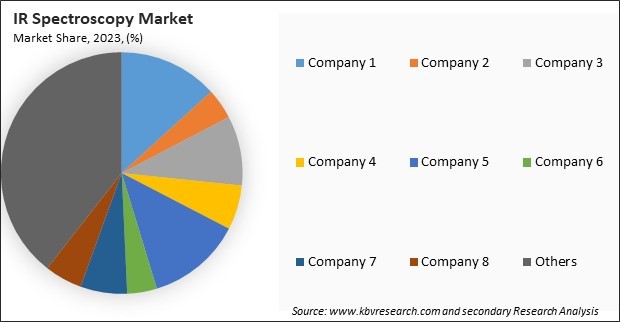
The leading players in the market are competing with diverse innovative offerings to remain competitive in the market. The above illustration shows the percentage of revenue shared by some of the leading companies in the market. The leading players of the market are adopting various strategies in order to cater demand coming from the different industries. The key developmental strategies in the market are Acquisitions, and Partnerships & Collaborations.
Based on technology, the market is characterized into dispersive and Fourier transform. In 2023, the Fourier transform segment recorded a 32.70% revenue share in the market. Within the domain of infrared spectroscopy, Fourier Transform Infrared (FT-IR) spectroscopy is among the most prevalent methods. It has become a cornerstone in various industries and research fields due to its versatility, sensitivity, and ease of use. Its widespread adoption is attributed to several factors, including its ability to rapidly acquire high-quality spectra over a broad spectral range, typically from the far-infrared to the near-infrared.
On the basis of type, the market is classified into near-infrared spectroscopy, mid-infrared spectroscopy, and far-infrared spectroscopy. The near-infrared spectroscopy segment garnered the 59.79% revenue share in the market in 2023. Near-infrared spectroscopy, also known as NIR spectroscopy, is a technique that emphasizes the near-infrared region of the electromagnetic spectrum, which typically ranges from 780 to 2500 nanometers. It is considered to be an important technique within the field of infrared spectroscopy. NIR spectroscopy occupies a prominent position within the IR spectroscopy market, offering valuable capabilities for a wide range of industrial and research applications.
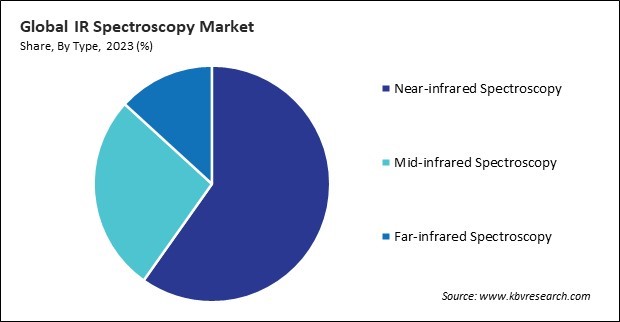
By product type, the market is fragmented into benchtop spectroscopes, micro spectroscopes, portable spectroscopes, and hyphenated spectroscopes. In 2023, the micro spectroscopes segment acquired a 19.91% revenue share in the market. Micro spectroscopy in IR spectroscopy finds applications across various fields such as materials science, pharmaceuticals, forensics, biology, geology, and semiconductor analysis. Its wide-ranging applications, imaging capabilities, and high spatial resolution make it invaluable for both academic research and industrial R&D in various fields.
Based on end-user, the market is classified into healthcare & pharmaceuticals, chemicals, food & beverages, environmental, biological research, and consumer electronics. The healthcare and pharmaceuticals segment recorded the 44.21% revenue share in the market in 2023. In this sector, infrared (IR) spectroscopy is widely employed for a range of applications, including drug discovery, formulation development, quality control, and regulatory compliance.
Free Valuable Insights: Global IR Spectroscopy Market size to reach USD 1.8 Billion by 2031
Region-wise, the market is analyzed across North America, Europe, Asia Pacific, and LAMEA. The Asia Pacific region held a 25.54 % revenue share in the market in 2023. The Asia-Pacific region presents opportunities for the adoption of IR spectroscopy for quality control, safety assessment, and authenticity verification of food products. These uses are driven by factors such as rapid industrialization, expanding healthcare and pharmaceutical sectors, growing chemical and petrochemical industries, increasing focus on environmental monitoring, and government support for research and development activities.
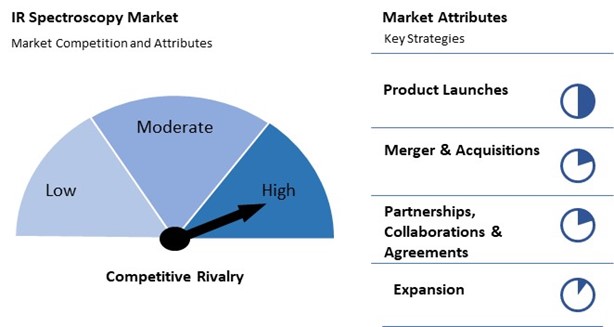
Competition in the IR spectroscopy market is fierce, with established players like Thermo Fisher Scientific, Inc., Hitachi High-Tech Corporation and ABB Group driven by innovation, product variety, customer service, and regulatory compliance. Companies vie for dominance through technological advancements, diverse product portfolios, global expansion, and competitive pricing. Success hinges on staying ahead in technology, meeting customer needs, and adhering to industry regulations.
| Report Attribute | Details |
|---|---|
| Market size value in 2023 | USD 1.1 Billion |
| Market size forecast in 2031 | USD 1.8 Billion |
| Base Year | 2023 |
| Historical Period | 2020 to 2022 |
| Forecast Period | 2024 to 2031 |
| Revenue Growth Rate | CAGR of 6.3% from 2024 to 2031 |
| Number of Pages | 311 |
| Number of Tables | 474 |
| Report coverage | Market Trends, Revenue Estimation and Forecast, Segmentation Analysis, Regional and Country Breakdown, Competitive Landscape, Market Share Analysis, Porter’s 5 Forces Analysis, Company Profiling, Companies Strategic Developments, SWOT Analysis, Winning Imperatives |
| Segments covered | Technology, Type, Product Type, End-user, Region |
| Country scope |
|
| Companies Included | Shimadzu Corporation, Carl Zeiss AG, Revvit, Inc, Agilent Technologies, Inc., Bruker Corporation, ABB Group, Thermo Fisher Scientific, Inc. Horiba Ltd., Sartorius AG, Hitachi High-Tech Corporation (Hitachi, Ltd) |
By Technology
By Type
By Product Type
By End-User
By Geography
This Market size is expected to reach $1.8 billion by 2031.
Advancements In Instrumentation And Technology are driving the Market in coming years, however, Complexity Of Data Interpretation restraints the growth of the Market.
Shimadzu Corporation, Carl Zeiss AG, Revvit, Inc, Agilent Technologies, Inc., Bruker Corporation, ABB Group, Thermo Fisher Scientific, Inc. Horiba Ltd., Sartorius AG, Hitachi High-Tech Corporation (Hitachi, Ltd)
The expected CAGR of this Market is 6.3% from 2024 to 2031.
The Benchtop Spectroscopes segment is leading the Market by Product Type in 2023 thereby, achieving a market value of $829.9 million by 2031.
The North America region dominated the Market by Region in 2023, and would continue to be a dominant market till 2031; thereby, achieving a market value of $665.7 million by 2031.
Our team of dedicated experts can provide you with attractive expansion opportunities for your business.
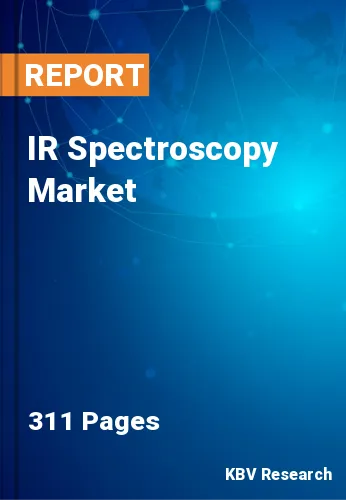
 Drivers
Drivers
 Restraints
Restraints
 Opportunities
Opportunities
 Challenges
Challenges
